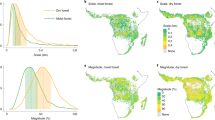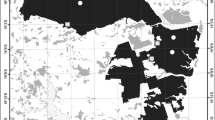Abstract
Compared to burn interiors, edges exhibit distinct biotic and abiotic conditions that include microclimate, wind speed, sunlight levels, soil composition, moisture content, nutrient availability, population density, and species diversity. This study characterized the landscapes in which burned forest edges formed in Samcheok, Korea. Over the study area, 500-m2 grid cells were generated to capture landscape characteristics. Grid cells intersecting burn boundary lines were designated as edge, while cells without these lines were classified as the interior of burned areas. Topographic variables including slope, elevation, topographic wetness index, solar radiation index, and proportions of fuel and land use types within grid cells were computed in a geographical information system (GIS). Correlation analysis with modified t-test and regression tree analysis were performed to explore the influences of landscape variables on edge formation with avoiding spatial autocorrelation problems. The results indicated that edges formed at low elevations with mild slopes, high topographic wetness, and low solar radiation. Edges were unlikely to form in areas dominated by Japanese red pines at low elevations. Moreover, heterogeneous land use/cover types contributed significantly to edge formation. Different forest management strategies for different landscape conditions can be more effective for enhancing resilience of forests to fire. Reducing susceptible fuel types might be effective at low elevations, while enhancing forest heterogeneity might be more effective at high elevations.
Similar content being viewed by others
References
Agee JK, Skinner CN (2005) Basic principles of forest fuel reduction treatments. Forest Ecology and Management 211: 83–96. DOI: 10.1016/j.foreco.2005.01.034
Agee JK, Bahro B, Finney MA, et al. (2000) The use of shaded fuelbreaks in landscape fire management. Forest Ecology and Management 127: 55–66.
Archibald S, Roy DP, van Wilgen BW, et al. (2009) What limits fire? An examination of drivers of burnt area in Southern Africa. Global Change Biology 15: 613–630. DOI: 10.1111/j.1365-2486.2008.01754.x
Baker K, French K, Whelan RJ (2002) The edge effect and ecotonal species: bird communities across a natural edge in southeastern Australia. Ecology 83: 3048–3059
Bessie WC, Johnson EA (1995) The relative importance of fuels and weather on fire behavior in subalpine forests. Ecology 76: 747–762.
Bigler C, Kulakowski D, Veblen TT (2005) Multiple disturbance interactions and drought influence fire severity in Rocky Mountain subalpine forests. Ecology 86:3018–3029
Cadenasso ML, Traynor MM, Pickett STA (1997) Functional location of forest edges: gradients of multiple physical factors. Canadian Journal of Forest Research 27: 774–782. DOI: 10.1139/x97-013
Calbk ME, White D, Kiester AR (2002) Assessment of spatial autocorrelation in empirical models of ecology. In: Scott JM, Heglund PJ, Morrison ML, et al. (eds.), Predicting Species Occurrences-Issues of Accuracy and Scale. Island Press, Washington, DC. pp 429–440.
Cardille JA, Ventura SJ (2001) Occurrence of wildfire in the northern Great Lakes region: effects of land cover and land ownership assessed at multiple scales. International Journal of Wildland Fire 10: 145–154. DOI: 10.1071/WF01010
Cary GJ, Keane RE, Gardner RH, et al. (2006) Comparison of the sensitivity of landscape-fire succession models to variation in terrain, fuel pattern, climate and weather. Landscape Ecology 21: 121–137. DOI: 10.1007/s10980-005-7302-9
Ceccato P, Leblon B, Chuvieco E, et al. (2003) Estimation of live fuel moisture content. In Wildland Fire Danger Estimation and Mapping. The Role of Remote Sensing Data. pp. 63–90 (Ed. E Chuvieco) (World Scientific Publishing, Singapore)
Christensen NL, Golley FB, Richards JR (1989) Landscape history. Bulletin of the Ecological Society of America 10: 155–157.
Collins BM, Kelly M, van Wagtendonk JW, et al. (2007) Spatial patterns of large natural fires in Sierra Nevada wilderness areas. Landscape Ecology 22: 545–557. DOI: 10.1007/s10980-006-9047-5
Cumming SG (2001) Forest type and wildfire in the Alberta boreal mixed wood: what do fires burn? Ecological Applications 11: 97–110.
Dasgupta S, Qu JJ, Hao XJ, et al. (2007) Evaluating remotely sensed live fuel moisture estimations for fire behavior predictions in Georgia, USA. Remote Sensing of Environment 108:138–150. DOI: 10.1016/j.rse.2006.06.023
Davies-Colley RJ, Payne GW, van Elswijk M (2000) Microclimate gradients across a forest edge. New Zealand Journal of Ecology 24: 111–121
Didham RK, Lawton JH (1999) Edge structure determines the magnitude of changes in microclimate and vegetation structure in tropical forest fragments. Biotropica 31:17–30. DOI: 10.1111/j.1744-7429.1999.tb00113.x
Dutilleul P (1993) Modifying the t test for assessing correlation between two spatial processes. Biometrics 49: 305–314
Finney MA, McHugh CW, Grenfell IC (2005) Stand- and landscape-level effects of prescribed burning on two Arizona wildfires. Canadian Journal of Forest Research 35: 1714–1722. DOI: 10.1139/X05-090
Forman RTT (1995) Land Mosaics. The Ecology of Landscapes and Regions. (Cambridge University Press, Cambridge, UK)
Gamma Design Software (2008) GS+ User’s Guide Version 9. (Plainwell, MI)
Gasaway WC, DuBois SD (1985) Initial response of moose to a wildfire in interior Alaska. Canadian Field-Naturalist 99:135–140
Gosz JR (1991) Fundamental ecological characteristics of landscape boundaries. In: Holland M, Risser P, Naiman R (eds.), The role of landscape boundaries in the management and restoration of changing environments. Chapman & Hall, New York, NY. pp. 8–30.
Gruber S, Peckham S (2008) Land-surface parameters and objects in hydrology. In: Hengl T, Reuter HI (eds.), Geomorphometry: Concepts, Software, Applications. Elsevier, Amsterdam. pp. 171–194.
Gustafson EJ, Zollner PA, Sturtevant BR, et al. (2004) Influence of forest management alternatives and land type on susceptibility to fire in northern Wisconsin, USA. Landscape Ecology 19: 327–342
Haining R (2003) Spatial Data Analysis: Theory and Practice. (Cambridge University Press, Cambridge, UK)
Hall SA, Burke IC (2006) Considerations for characterizing fuels as inputs for fire behavior models. Forest Ecology and Management 227:102–114. DOI: 10.1016/j.foreco.2006.02.022
Harper KA, Macdonald SE, Burton PJ, et al. (2005) Edge influence on forest structure and composition in fragmented landscapes. Conservation Biology 19:768–782. DOI: 10.1111/j.1523-1739.2005.00045.x
Hilmo O, Holien H (2002) Epiphytic lichen response to the edge environment in a boreal Picea abies forest in central Norway. The Bryologist 105: 48–56. DOI: 10.1639/0007-2745(2002)105[0048:ELRTTE]2.0.CO;2
Kerby JD, Fuhlendorf SD, Engle DM (2007) Landscape heterogeneity and fire behavior: scale-dependent feedback between fire and grazing processes. Landscape Ecology 22: 507–516. DOI: 10.1007/s10980-006-9039-5
Kopecký M, Čížková Š (2010) Using topographic wetness index in vegetation ecology: does the algorithm matter?. Applied Vegetation Science 13: 450–459. DOI: 10.1111/j.1654-109X.2010.01083.x
Korea Forest Service (2001) Comprehensive report of forest fires in eastern regions. Korea Forest Service 1: 33–36.
Kushla JD, Ripple WJ (1997) The role of terrain in a fire mosaic of a temperate coniferous forest. Forest Ecology and Management 95: 97–07. DOI: 10.1016/s0378-1127(97)82929-5.
LaCroix JL, Ryu S, Zheng D, et al. (2006) Simulating fire spread with landscape management scenarios. Forest Science 52: 522–529.
Lee DB, Chung JS, Lim HH, et al. (2001) Analyzing spread rate of Samcheok forest fire broken out in 2000 using GIS. Korean Forest Society 90: 781–787.
Lee SW, Lee MB, Lee YG, et al. (2009) Relationship between landscape structure and burn severity at the landscape and class levels in Samcheok, South Korea. Forest Ecology and Management 258:1594–1604. DOI: 10.1016/j.foreco.2009.07.017
Lentile LB, Holden ZA, Smith AMS, et al. (2006) Remote sensing techniques to assess active fire characteristics and post-fire effects. International Journal of Wildland Fire 15: 1–27. DOI: 10.1071/WF05097
Lloret F, Calvo E, Pons X, et al. (2002) Wildfires and landscape patterns in the eastern Iberian Peninsula. Landscape Ecology 17: 745–759.
Luke RH, McArthur AG (1978) Bushfires in Australia. (Australian Government Printing Service, Canberra, Australia)
McCune B, Keon D (2002) Equations for potential annual direct incident radiation and heat load. Journal of Vegetation Science 13: 603–606. DOI: 10.1111/j.1654-1103.2002.tb02087.x
Mermoz M, Kitzberger T, Veblen TT (2005) Landscape influences on occurrence and spread of wildfires in Patagonian forests and shrublands. Ecology 86: 2705–2715. DOI: 10.1890/04-1850
Murphy PNC, Ogilvie J, Arp P (2009) Topographic modeling of soil moisture conditions: a comparison and verification of two models. European Journal of Soil Science 60: 94–109. DOI: 10.1111/j.1365-2389.2008.01094.x
Nunes MCS, Vasconcelos MJ, Pereira JMC, et al. (2005) Land cover type and fire in Portugal: do fires burn land cover selectively?. Landscape Ecology 20: 661–673. DOI: 10.1007/s10980-005-0070-8
Parks WC, Wilson CL, Lopez-Boado YS (2004) Matrix metalloproteinases as modulators of inflammation and innate immunity. Nature Reviews Immunology 4: 617–629. DOI: 10.1038/nri1418
Rangel TF, Diniz JAF, Bini LM (2010) SAM: a comprehensive application for spatial analysis in macroecology. Ecography 33: 46–50. DOI: 10.1111/j.1600-0587.2009.06299.x
Ries L, Fletcher RJJ, Battin J, et al. (2004) Ecological responses to habitat edges: mechanisms, models, and variability explained. Annual Review of Ecology, Evolution and Systematics 35: 491–522. DOI: 10.1146/annurev.ecolsys.35.112202.130148
Ritchie MW, Skinner CN, Hamilton TA (2007) Probability of wildfire-induced tree mortality in an interior pine forest: effects of thinning and prescribed fire. Forest Ecology and Management 247: 200–208. DOI: 10.1016/j.foreco.2007.04.044
Ryu SR, Chen J, Zheng D, et al. (2007) Relating surface fire spread to landscape structure: an application of FARSITE in a managed forest landscape. Landscape and Urban Planning 83: 275–283. DOI: 10.1016/j.landurbplan.2007.05.002
Scott JH, Reinhardt ED (2001) Assessing crown fire potential by linking models of surface and crown fire behavior. USDA Forest Service, Rocky Mountain Research Station Research Paper RMRS-29.
Skinner CN, Ritchie MW, Hamilton T, et al. (2004) Effects of prescribed fire and thinning on wildfire severity: the Cone Fire, Blacks Mountain Experimental Forest Proceedings of the 25th Annual Forest Vegetation Management Conference Redding, CA, 20–24 January. pp 80–91
Strom BA, Fulé PZ (2007) Pre-wildfire fuel treatments affect long-term ponderosa pine forest dynamics. International Journal of Wildland Fire 16: 128–138. DOI: 10.1071/WF06051
Summerell GK, Dowling TI, Wild JA, Beale G (2004) FLAG UPNESS and its application for mapping seasonally wet to waterlogged soils. Australian Journal of Soil Research 42: 155–162. DOI: 10.1071/SR03028
Trollope WSW (1984) Fire in savanna. In: Booysen PDV, Tainton NM (eds.), Ecological Effects of Fire in South African Ecosystems. Springer-Verlag, Berlin, Germany. pp. 199–218.
Turner MG, Hargrove WW, Gardner RH, et al. (1994) Effects of fire on landscape heterogeneity in Yellowstone National Park, Wyoming. Journal of Vegetation Science 5: 731–742.
Turner MG, Romme WH (1994) Landscape dynamics in crown fire ecosystems. Landscape Ecology 9: 57–77.
Van Wagner CE (1977) Conditions for the start and spread of crown fire. Canadian Journal of Forest Research 7: 23–34. DOI: 10.1139/x77-004
Viegas DX, Viegas TP, Ferreira AD (1992). Moisture content of fine forest fuels and fire occurrence in central Portugal. International Journal of Wildland Fire 2: 69–85. DOI: 10.1071/WF9920069
Weise DR, Biging GS (1996) Effects of wind velocity and slope on flame properties. Canadian Journal of Forest Research 26: 1849–1858. DOI: 10.1139/x26-210
Weise DR, Biging GS (1997) A qualitative comparison of fire spread models incorporating wind and slope effects. Forest Science 43: 170–180
Wimberly MC, Reilly MJ (2007) Assessment of fire severity and species diversity in the southern Appalachians using Landsat TM and ETM+ imagery. Remote Sensing of Environment 108: 189–197. DOI: 10.1016/j.rse.2006.03.019
Wood SW, Murphy BP, Bowman DMJS (2011) Firescape ecology: how topography determines the contrasting distribution of fire and rain forest in the south-west of the Tasmanian Wilderness World Heritage Area. Journal of Biogeography 38: 1807–1820. DOI: 10.1111/j.1365-2699.2011.02524.x
Zhou X, Mahalingam S, Weise D (2005) Modeling of marginal burning state of fire spread in live chaparral shrub fuel bed. Combustion and Flame 143: 183–198. DOI: 10.1016/j.combustflame.2005.05.013
Author information
Authors and Affiliations
Corresponding author
Rights and permissions
About this article
Cite this article
Lee, SW., Won, MS., Lee, JM. et al. Intermediate-scale analysis of landscape characteristics affecting edge formation in burned forests in Samcheok, Korea. J. Mt. Sci. 11, 384–397 (2014). https://doi.org/10.1007/s11629-013-2644-2
Received:
Accepted:
Published:
Issue Date:
DOI: https://doi.org/10.1007/s11629-013-2644-2




